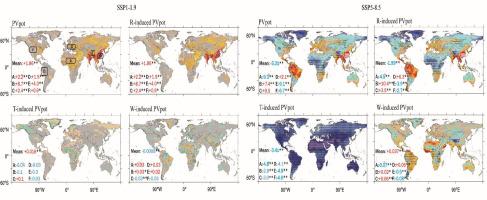Historical and future climate changes impact global solar photovoltaic power potential: Role of key meteorological variables
IF 3.2
4区 地球科学
Q3 METEOROLOGY & ATMOSPHERIC SCIENCES
引用次数: 0
Abstract
Renewable energy, especially solar power, is vital for mitigating global warming, while climate change also impacts solar photovoltaic potential (PVpot). This study analyzes historical (1985–2014) and future (2015–2100) climate effects on PVpot, and quantifies contributions from changed radiation, temperature, and wind speed. Historically, global PVpot increased by 0.42 ‰, with notable rises in eastern China (+7.1 ‰) and southern Europe (+3.5 ‰). By the end of the century, increased radiation-induced PVpot (+1.27 ‰) offsets temperature-induced PVpot loss (−0.54 ‰) under SSP1-2.6, yielding a net PVpot increase (+0.74 ‰). Under SSP2-4.5, the temperature-induced PVpot decline (−1.50 ‰) drives the final PVpot reduction (−1.15 ‰). Under SSP3-7.0 and SSP5-8.5, combined radiation-induced (−1.94 ‰ and −1.99 ‰) and temperature-induced PVpot changes (−2.67 ‰ and −3.41 ‰) result in significant PVpot declines (−4.57 ‰ and −5.31 ‰). Regional analysis reveals that eastern China (+0.7‰ to +8.6 ‰), southern Europe (+0.3 ‰ to +2.5 ‰), and Northwest South America (+0.6 ‰ to +2.1 ‰) retain positive changes in future PVpot across all climate scenarios, which may be due to reduced aerosols and cloud cover, suggesting these areas can remain suitable for photovoltaic installations despite climate changes. In contrast, temperature-driven PVpot declines over the Qinghai–Tibet Plateau (−9.1 ‰ to −4.3 ‰) and northern Africa (−9.3 ‰ to −4.9 ‰) under future high-emission scenarios indicate that these historically advantageous regions will become less suitable for solar energy deployment. The findings underscore that climate changes driven by sustainable development pathways will generate more PVpot in the future for better global warming mitigation.
摘要
可再生能源, 特别是太阳能发电对于减缓全球变暖至关重要, 但气候变化会影响太阳能光伏潜力 (PVpot) . 本研究分析了历史 (1985–2014年) 和未来 (2015–2100年) 气候对PVpot的影响, 量化了辐射, 温度和风速的贡献. 从历史上看, 全球PVpot增加了0.42 ‰, 其中中国东部 (+7.1 ‰) 和南欧 (+3.5 ‰) 的增长显著. 到本世纪末, 在SSP1-2.6下, 辐射引起的PVpot增加 (+1.27 ‰) 抵消了温度引起的PVpot损失 (−0.54 ‰) , 从而PVpot增加 (+0.74 ‰). 在SSP2-4.5下, 温度引起的PVpot下降 (−1.50 ‰) 导致最终PVpot减少 (−1.15 ‰) . 在SSP3-7.0和SSP5-8.5中, 辐射引起的 (−1.94 ‰和−1.99 ‰) 和温度引起的PVpot变化 (−2.67 ‰和−3.41 ‰) 共同导致PVpot显著下降 (−4.57 ‰和−5.31 ‰) . 区域分析表明, 中国东部 (+0.7 ‰∼+8.6 ‰) , 南欧 (+0.3 ‰∼+2.5 ‰) 和南美洲西北部 (+0.6 ‰∼+2.1 ‰) 在所有气候情景下的PVpot都保持正变化, 这可能是由于气溶胶和云量减少, 这表明尽管未来气候变化, 这些地区仍然适合安装光伏设备. 相比之下, 在高排放情景下, 青藏高原 (−9.1 ‰∼−4.3 ‰) 和北非 (−9.3‰∼−4.9 ‰) 的光伏发电量因温度升高而下降, 这些历史上有利的地区将不再适合部署太阳能. 本研究结果强调, 可持续发展道路推动的气候变化将在未来产生更多的光伏发电量, 从而更好地减缓全球变暖.

历史和未来气候变化对全球太阳能光伏发电潜力的影响:关键气象变量的作用
可再生能源,尤其是太阳能,对于减缓全球变暖至关重要,而气候变化也会影响太阳能光伏潜力(PVpot)。本研究分析了历史(1985-2014)和未来(2015-2100)气候对PVpot的影响,并量化了辐射、温度和风速变化的贡献。从历史上看,全球PVpot增加了0.42‰,其中中国东部(+7.1‰)和南欧(+3.5‰)的增幅显著。到本世纪末,在SSP1-2.6下,辐射引起的PVpot增加(+1.27‰)抵消了温度引起的PVpot损失(- 0.54‰),产生净PVpot增加(+0.74‰)。在SSP2-4.5下,温度诱导的PVpot下降(- 1.50‰)驱动最终PVpot降低(- 1.15‰)。在SSP3-7.0和SSP5-8.5下,辐射诱导(- 1.94‰和- 1.99‰)和温度诱导(- 2.67‰和- 3.41‰)导致PVpot显著下降(- 4.57‰和- 5.31‰)。区域分析显示,中国东部地区(+0.7‰~ +8.6‰)、南欧地区(+0.3‰~ +2.5‰)和南美洲西北部地区(+0.6‰~ +2.1‰)在所有气候情景下,未来PVpot均保持正变化,这可能是由于气溶胶和云层的减少,表明这些地区在气候变化的情况下仍然适合光伏安装。在未来的高排放情景下,北非(- 9.3‰至- 4.9‰)和北非(1‰至- 4.3‰)表明这些历史上具有优势的地区将不再适合太阳能的部署。研究结果强调,可持续发展路径驱动的气候变化将在未来产生更多的PVpot,以更好地减缓全球变暖。摘要可再生能源,特别是太阳能发电对于减缓全球变暖至关重要,但气候变化会影响太阳能光伏潜力(PVpot)。本研究分析了历史(1985 - 2014年)和未来(2015 - 2100年)气候对PVpot的影响,量化了辐射,温度和风速的贡献。从历史上看,全球PVpot增加了0.42‰,其中中国东部(+ 7.1‰)和南欧(+ 3.5‰)的增长显著。到本世纪末,在ssp1 - 2.6下,辐射引起的PVpot增加(+ 1.27‰)抵消了温度引起的PVpot损失(−0.54‰),从而PVpot增加(+ 0.74‰)。在ssp2 - 4.5下,温度引起的PVpot下降(−1.50‰)导致最终PVpot减少(−1.15‰)。在ssp3 - 7.0和ssp5 - 8.5中,辐射引起的(−1.94‰和−1.99‰)和温度引起的PVpot变化(−2.67‰和−3.41‰)共同导致PVpot显著下降(−4.57‰和−5.31‰)。区域分析表明,中国东部(+ 0.7‰∼+ 8.6‰),南欧(+ 0.3‰∼+ 2.5‰)和南美洲西北部(+ 0.6‰∼+ 2.1‰)在所有气候情景下的PVpot都保持正变化,这可能是由于气溶胶和云量减少,这表明尽管未来气候变化,这些地区仍然适合安装光伏设备。相比之下,在高排放情景下,青藏高原(−9.1‰∼−4.3‰)和北非(−9.3‰∼−4.9‰)的光伏发电量因温度升高而下降,这些历史上有利的地区将不再适合部署太阳能。本研究结果强调, 可持续发展道路推动的气候变化将在未来产生更多的光伏发电量, 从而更好地减缓全球变暖.
本文章由计算机程序翻译,如有差异,请以英文原文为准。
求助全文
约1分钟内获得全文
求助全文
来源期刊

Atmospheric and Oceanic Science Letters
METEOROLOGY & ATMOSPHERIC SCIENCES-
CiteScore
4.20
自引率
8.70%
发文量
925
审稿时长
12 weeks
 求助内容:
求助内容: 应助结果提醒方式:
应助结果提醒方式:


